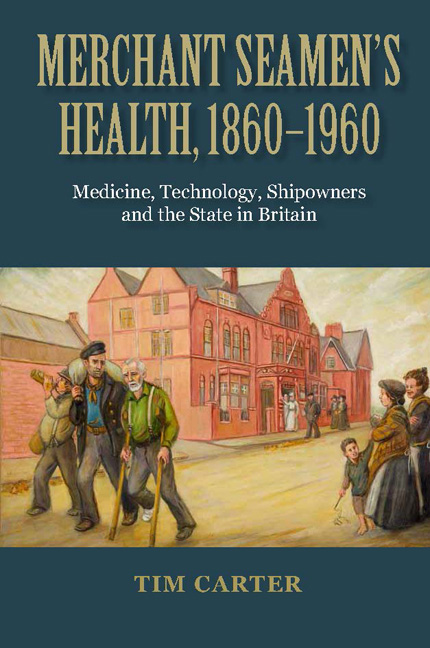Book contents
- Frontmatter
- Dedication
- Contents
- List of Illustrations
- Preface
- Acknowledgements
- List of Abbreviations
- Glossary of nautical terms used
- Introduction
- 1 Health at sea before 1860
- 2 Unseaworthy seamen
- 3 The health of merchant seamen in the nineteenth century
- 4 Injury and disease at sea in the nineteenth century
- 5 The seaman ashore: victim, threat or patient?
- 6 Bad food and donkey's breakfasts
- 7 Fit for lookout duties
- 8 The long-term health of seamen
- 9 War, manpower and fitness for service
- 10 Seamen's health in the welfare state
- 11 Retrospect and prospect
- Bibliography
- Index
5 - The seaman ashore: victim, threat or patient?
Published online by Cambridge University Press: 05 November 2014
- Frontmatter
- Dedication
- Contents
- List of Illustrations
- Preface
- Acknowledgements
- List of Abbreviations
- Glossary of nautical terms used
- Introduction
- 1 Health at sea before 1860
- 2 Unseaworthy seamen
- 3 The health of merchant seamen in the nineteenth century
- 4 Injury and disease at sea in the nineteenth century
- 5 The seaman ashore: victim, threat or patient?
- 6 Bad food and donkey's breakfasts
- 7 Fit for lookout duties
- 8 The long-term health of seamen
- 9 War, manpower and fitness for service
- 10 Seamen's health in the welfare state
- 11 Retrospect and prospect
- Bibliography
- Index
Summary
Dangers in ports
The health of seamen was at risk not only while at sea but possibly even more so whilst in port. The Merchant Shipping Acts could require arrangements to be made for disease prevention and treatment at sea but the seafarer ashore had no such protection. They became legitimate prey for a wide range of predators, from the disease-bearing mosquitoes of tropical ports and anchorages to the nexus of boarding-house keepers, bar owners, crimps, pimps and prostitutes in all the port cities of the world. The risks to the health of seafarers whilst in port were a pressing practical issue in terms of the provision of crews and their competence, but it was also an issue that was laden with moral overtones in the nineteenth century.
As seen, most of the information that we have on the health of seamen in the nineteenth century comes from shore-based hospitals that met their needs for care. These data show that, while a few diseases like scurvy and many accidents arose from conditions at sea, many were exotic conditions caught in foreign ports, and even some of the others, like typhoid in coaster crews, were likely to have had their origins in insanitary port areas or contaminated food or water brought aboard.
- Type
- Chapter
- Information
- Merchant Seamen's Health, 1860–1960Medicine, Technology, Shipowners and the State in Britain, pp. 68 - 84Publisher: Boydell & BrewerPrint publication year: 2014



